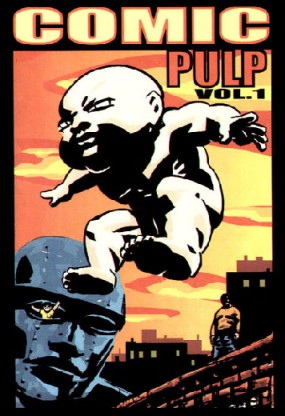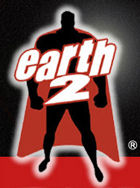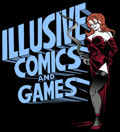| Comic
Pulp v.1
I’m
usually wary when I review comics from what can arguably
be called the comics small press. The reason is that I have
no problem holding the small press to the same standard
as I hold the larger publishing houses.
I do
have to wonder if this is fair. The larger companies have
the means to produce a superior product: better paper grades,
inks, coloring. They have editors that go over the work
of the lesser experienced artists, which I’m sure
is both a blessing for those writers who need the help and
a curse to those that see their creativity as being stifled
by the editorial process. The truly small press publisher
is more than likely a collection of artists who have banded
together to get their own work published and out to the
readership. Creatively, they have no one to hold them back,
but practically, they have no support and no editorial direction.
So it
comes down to Comic Pulp. And it doesn’t
come down to a very good place.
Writer and artist
Ted Seko seems to be reaching for some very large themes
concerning the nature of man in his story about the very
recently born Billy Cole, a baby that can fly, has super-strength,
and is naked all the time. Billy is born and suddenly decides
to fight Evil. Who Evil is and how to fight him is not known
to Billy, so he enlists the help of a street bum, a wrestler,
and some kid with a giant robot. With their help Billy manages
to defeat Evil, and then goes fishing.
The
above paragraph describes a setting and cast of characters
that could easily be a hilarious collection of strangeness
and parody that might have made this a good comic, but the
truth is that the author plays almost all of this straight.
It’s not meant to be funny, or wry, or sardonic and
if it is, then the author has failed miserably at getting
that across to the reader.
Instead
the entirety of the “story” is Billy flying
around an unnamed city, punching people he sees as evil.
At various points, he will run into a nameless and almost
physically indistinguishable person that will begin one
of the many expositions of this book. These little monologues
that appear so frequently are vastly annoying for two reasons,
the first being that they are long, pointless, and have
nothing to do with anything. They serve no direct purpose
in the text and one has little to do with the other. There
is no flow to the dialogue of this book, so the illusion
of voice and character is immediately lost.
This
leads to the second annoying habit of this collection; since
there are no real characters here, the reader is made painfully
aware that these monologues are just the work of the author.
They end up being rants about various topics, ranging from
how TV rots the mind to the author’s slight criticism
of modern religion and science. They have nothing to do
with the story (as if there was one), and even if they somehow
flowed well, the things the author writes about are so clichéd
that they are made boring and unreadable. It sounds at times
as if the author is simply regurgitating bits and pieces
from the monologues of other people, getting the gist of
them but not making it readily understandable exactly what
he is trying to accomplish.
The
artwork is abysmal. Seko has no eye for anatomy, and every
character, save for Billy Cole, is a black and white pile
of square lumps of muscle that are indistinguishable from
each other. This does not overly matter since the figures
don’t say much after their individual rants, and just
fade into the often only-black background. There are hardly
any backgrounds to speak of, and Seko’s pacing is
not consistent or helpful to the reader. Proportions and
lighting change, all without warning and seemingly no cause.
That
may be the major problem with the work. The author has no
real direction to go in, no idea of what story he is trying
to tell. Many of his rants lean toward self-discovery and
not being reliant on the material world, but there’s
no story to connect those themes. Seko obviously wants to
do a story that concerns big issues about the human condition,
but he doesn’t appear to have the ability to pull
it off. This is a prime example of a small press comic whose
author does not know the basic fundamentals of storytelling,
which are the foundation that every good comic has to have,
and tried to get around that fact by spewing rhetorical
nonsense onto a comics page in lieu of actual story dynamics.
Seko
could be a great writer and an artist, but we’ll never
know if he can’t be bothered to learn the form of
his chosen medium. Even at $6.95 from Picture Perfect Press,
this isn’t worth buying.
|






